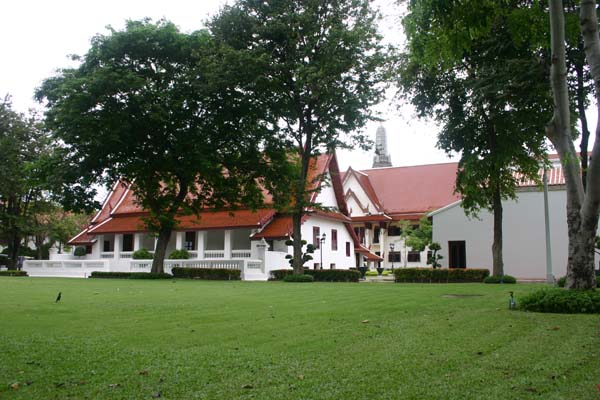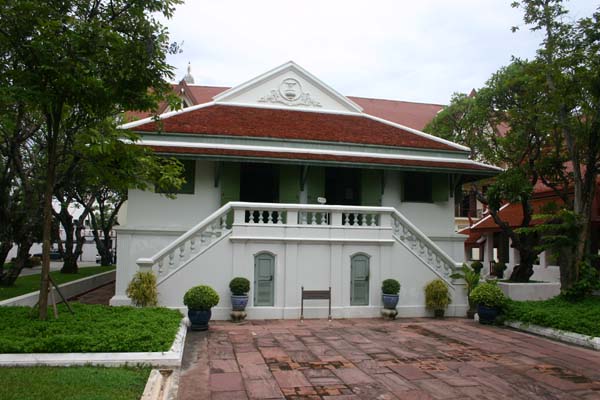
The buildings of the Thonburi Palace, with the throne hall on the left.
In 1767, a general and provincial governor named Taksin managed to re-assert Thai rule over most of Siam, after the Burmese had attacked and sacked the old capital in Ayuthaya. With the old city in ruins, the newly crowned King Taksin decided to establish the new capital in Thonburi, on the western bank of the Chaophraya River opposite where Bangkok stands today.
The new king built his palace in the new capital next to the old temple of Wat Arun (called Wat Chaeng at the time), which also placed it just behind the existing fortifications that guarded access to the kingdom's ports. The remains of the palace consists of just one main building, an open air throne hall where audiences were held which is attached to the king's main residence. There originally would have been many wooden residence buildings behind the throne hall, in the "inner court" area that was restricted to women and children.
Together with another general named Chakri, Taksin managed to regain control over most of Thailand as well as many Lao territories. Unfortunately, around 1782 King Taksin began to suffer from extreme paranoia to the extent that the privy counsel decided to have him put to death. General Chakri was named king, establishing a dynasty that exists to this day.

The "Chinese Residences" (right) built early in the 19th century, with the shrine to Taksin on the left and the Whale Head Shrine in between.
King Chakri, more generally known as King Rama I, decided to move the capital across the river, where Bangkok still stands today. He built the Grand Palace as his new residence. However, King Taksin's Palace was still a strategic place, and so remained occupied by key members of the royal family up to 1905, when it was turned over to the Royal Navy.

Whale head shrine.
Subsequent occupants added to the palace, which was now called Phra Rachawang Derm, or the "Original Palace." During the reigns of Kings Rama I and Rama II, a Chinese style of architecture was much in favor. Sometime before 1851, two Chinese styled residence halls were built between the throne hall and the river wall. The smaller residence was built first and now houses an exhibit of King Taksin's battle achievements as well as a collection of weapons dating from his time. The larger hall has some fine details on the gable ends and now displays maps, commercial goods and other exhibits recounting the nature of trade during King Taksin's time.
Next to the Chinese residences is a curious little shrine housing the bones of a large whale's head. Apparently, in the early days of Bangkok, it was not unusual for whales to occasionally be found in the Chaophraya River around Bangkok. Although little is known about the original shrine, it was probably built to house bones that were found in the grounds of the palace during the construction of one of the buildings. The present shrine is a reconstruction built in 1999.

The shrine to King Taksin.
Next to the Whale Head Shrine is a larger building housing a shrine to King Taksin himself. The current building is a reconstruction of a shrine originally built some time before 1900. Exactly why the shrine was built in the first place isn't known. The shrine houses a large statue of King Taksin in the high-peaked hat that was typical of the early Bangkok period.
A curious bit of trivia was imparted to me by our guide to the palace. In the days of King Taksin and the early Chakri Kings, it actually wasn't allowed to draw, sculpt, or otherwise make a likeness of the king. All of the current paintings and sculptures of the early kings you see around Thailand today were made in the nineteenth century based on written descriptions of the Kings.
In the gardens around the Throne Hall, you'll see short hedgerows planted in linear patterns as well as patterns in the brick walkways. These mark the foundations of other buildings found in the palace during excavations when the grounds were being reconstructed. Since there was little or no written information describing these buildings, the foundation organizing the reconstruction decided to mark them out rather than trying to rebuild the buildings.

King Pinklao's Residence.
The last large residence built in the palace was King Pinklao's Residence. King Pinklao actually held the office of "Second King" during the reign of King Rama III, but is still referred to as a King in his own right. His residence in the Thonburi Palace was built while he was still a Prince. When he became Second King, he moved to the "Front Palace," which is now the National Museum. The building was constructed during the early days of the American presence in Bangkok, and at the court, so the residence reflects some western practices of the time, such as a brick or stone first story with a wooden second floor.
King Pinklao's residence now houses various memorabilia related to King Pinklao, including letters regarding the negotiations of the infamous Bowring Treaty. In the ground floor is a display of both Thai and Chinese porcelain as well as some fine examples of gold nielloware. There is also a small book stand on the second floor where you can buy books (in English) describing the life and times of King Taksin in more detail.
The last building of special interest in the palace grounds is a small green wooden "gingerbread" house built sometime between 1900 and 1906. It was built during the reign of King Rama V when Prince Khrom Phra Chakrapadibhongse resided in the palace. The building was used for a time as an infirmary.
Prince Chakrapadibhongse was the last royal resident of the Palace. By the turn of the twentieth century, the palace had ceased to have much strategic importance, so it was turned over to the Royal Navy. The palace was used as the naval academy for a while, and then it became the headquarters of the navy. A purpose which it serves to this day.
In 1995, recognizing the historical importance of the palace, the navy formed a foundation to restore the palace buildings and open them to the public. The palace can be visited only by groups of five or more people, by prior arrangement with the foundation. Visit the Phra Racha Wang Derm Restoration Foundation web site for more information.